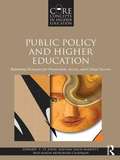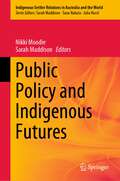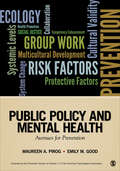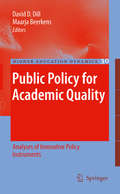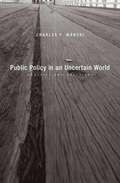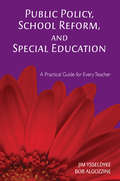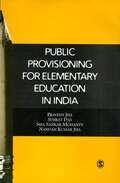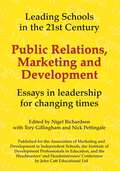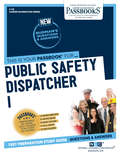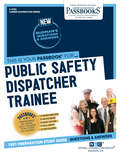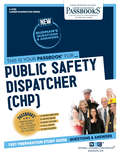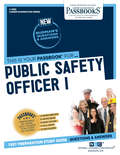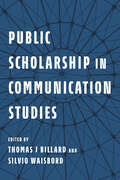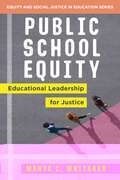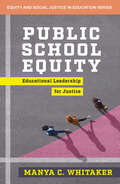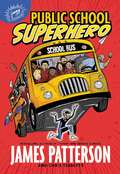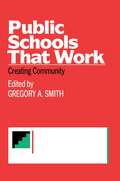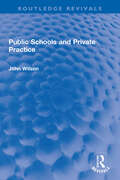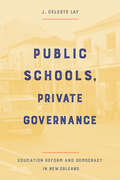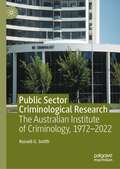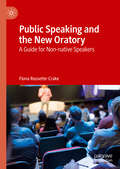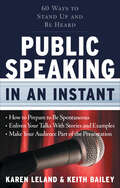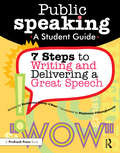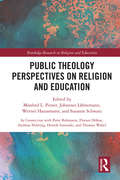- Table View
- List View
Public Policy and Higher Education: Reframing Strategies for Preparation, Access, and Success
by Nathan Daun-Barnett Edward P. St. John Karen M. Moronski-ChapmanAmid changing economic and social contexts, radical changes have occurred in public higher education policies over the past three decades. Public Policy and Higher Education provides readers with new ways to analyze these complex state policies and offers the tools to examine how policies affect students' access and success in college. Rather than arguing for a single approach, the authors examine how policymakers and higher education administrators can work to inform and influence change within systems of higher education using research-based evidence along with consideration of political and historical values and beliefs. Special Features: Case Studies--allow readers to examine strategies used by different types of colleges to improve access and retention. Reflective Exercises--encourage readers to discuss state and campus context for policy decisions and to think about the strategies used in a state or institution. Approachable Explanations--unpack complex public policies and financial strategies for readers who seek understanding of public policy in higher education. Research-Based Recommendations--explore how policymakers, higher education administrators and faculty can work together to improve quality, diversity, and financial stewardship. This textbook is an invaluable resource for graduate students, administrators, policymakers, and researchers who seek to learn more about the crucial contexts underlying policy decisions and college access.
Public Policy and Indigenous Futures (Indigenous-Settler Relations in Australia and the World #4)
by Sarah Maddison Nikki MoodieThis book focuses on Indigenous self-determined and community-owned responses to complex socioeconomic and political challenges in Australia, and explores Indigenous policy development and policy expertise. It critically considers current practices and issues central to policy change and Indigenous futures. The book foregrounds the resurgence that is taking place in Indigenous governing and policy-making, providing case studies of local and community-based policy development and implementation. The chapters highlight new Australian work on what is an international phenomenon.This book brings together senior and early career political scientists and policy scholars, and Indigenous and non-Indigenous scholars working on problems of Indigenous policy and governance.
Public Policy and Mental Health: Avenues for Prevention (Prevention Practice Kit)
by Pirog Maureen A. and Good Emily M.This eighth book in the Prevention Practice Kit provides a broad overview of the types of policies governments establish to prevent mental disorders as well as the various ways in which these policies are created. The authors describe the process of analyzing public programs, laws, policies, and managerial innovations in mental disorder prevention, and help readers examine both the rationale for these programs and policies and whether or not they really work.The text includes valuable case studies on the development of prevention interventions, the impact of individuals and organizations on policies, what happens when attempts to change policies are ineffective, and the considerable amount of effort that is often needed to create needed policy changes in the mental health arena. Questions are provided throughout the text to encourage the reader to engage the topics in a critical manner.This book is part of the Prevention Practice Kit: Action Guides for Mental Health, a collection of eight books each authored by scholars in the specific field of prevention and edited by Dr. Robert K. Conyne and Dr. Arthur M. Horne. The books in the collection conform to the editors′ outline to promote a consistent reading experience. Designed to provide human services practitioners, counselors, psychologists, social workers, instructors, and students with concrete direction for spreading and improving the practice of prevention, the series provides thorough coverage of prevention application including a general overview of prevention, best practices, diversity and cultural relevance, psychoeducational groups, consultation, program development and evaluation, evidence base, and public policy.This book is endorsed by the Prevention Section of the Society of Counseling Psychology of the American Psychological Association. Fifty percent of all royalties are donated to Division 17 of the APA.
Public Policy for Academic Quality
by Maarja Beerkens David D. DillOver the last decade the structure of higher education in most countries has undergone significant change brought about by social demands for expanded access, technological developments, and market forces. In this period of change the traditional concerns with access and cost have been supplemented by a new concern with academic quality. As a consequence, new public policies on academic quality and new forms of academic quality assurance have rapidly emerged and swiftly migrated across continents and around the globe. The growing public debate about academic quality assurance within and across countries however has not always been well informed by analyses of the strengths and weaknesses of these new policy instruments. The Public Policy for Academic Quality Research Program (PPAQ) was designed to provide systematic analyses of innovative external quality assurance policies around the world. This volume presents the fourteen analyses of national policies on academic quality assurance conducted as part of the PPAQ Research Program utilizing the knowledge of informed international scholars. Each policy analysis examines the policy goals, implementation problems, and impacts of these newly developed national quality assurance instruments. The book concludes with an assessment of the lessons learned from these collected policy analyses and outlines the framework conditions that appear essential for assuring academic standards in the university sector.
Public Policy in an Uncertain World
by Charles F. ManskiPublic policy advocates routinely assert that research has shown a particular policy to be desirable. But how reliable is the analysis in the research they invoke? And how does that analysis affect the way policy is made, on issues ranging from vaccination to minimum wage to FDA drug approval? Charles Manski argues here that current policy is based on untrustworthy analysis. By failing to account for uncertainty in an unpredictable world, policy analysis misleads policy makers with expressions of certitude. Public Policy in an Uncertain World critiques the status quo and offers an innovation to improve how policy research is conducted and how policy makers use research. Consumers of policy analysis, whether civil servants, journalists, or concerned citizens, need to understand research methodology well enough to properly assess reported findings. In the current model, policy researchers base their predictions on strong assumptions. But as Manski demonstrates, strong assumptions lead to less credible predictions than weaker ones. His alternative approach takes account of uncertainty and thereby moves policy analysis away from incredible certitude and toward honest portrayal of partial knowledge. Manski describes analysis of research on such topics as the effect of the death penalty on homicide, of unemployment insurance on job-seeking, and of preschooling on high school graduation. And he uses other real-world scenarios to illustrate the course he recommends, in which policy makers form reasonable decisions based on partial knowledge of outcomes, and journalists evaluate research claims more closely, with a skeptical eye toward expressions of certitude.
Public Policy, School Reform, and Special Education: A Practical Guide for Every Teacher
by Bob Algozzine Dr James E. YsseldykeCase studies illustrate how social, political, and economic factors affect special education practices and the distribution of limited resources to students with special needs.
Public Provisioning for Elementary Education in India
by Praveen K Jha Subrat Das Siba Sankar Mohanty Nandan Kumar JhaThis book analyses the magnitude of public expenditure on education, the composition of such expenditure, the flow of funds from the Centre to the districts, and the bottlenecks in the process, with a focus on elementary education. Most of the existing body of work in this area concentrates on Central Government`s budgetary provisions instead. The significance of this research lies in that it dwells on the major challenges confronting the States with regard to these issues. Public Provisioning for Elementary Education in India focuses on elementary education in the context of the ongoing efforts towards Universalising Elementary Education (UEE) in the country. The book tracks budget expenditures and budgetary and planning processes in the current flagship programme of Sarva Shiksha Abhiyan (SSA) across the four selected States of Andhra Pradesh, Bihar, Gujarat and Rajasthan. It addresses the causes of the fiscal crisis in States in the era of economic reforms, and the policy measures required for improving the flow of public expenditure on education. This book offers important insights for policymakers, academia and social activists interested in `Input—Process—Output—Impact` of State intervention in the education sector in general and elementary education in particular.
Public Relations, Marketing and Development: Essays in Leadership in Challenging Times
by Nigel Richardson Nick Pettingale Tory GillinghamThis inspiring book, the sixth in our popular Leading Schools in the 21st Century series, focuses on the specific requirements of independent schools in the UK. Published in partnership with the HMC, the Association of Marketing and Development in Independent Schools (AMDIS), and the Institute of Development Professionals in Education (IDPE), the book has been written by experienced professionals who are experts in their field.
Public Relations, Marketing and Development: Essays in Leadership in Challenging Times
by Nigel Richardson Nick Pettingale Tory GillinghamThis inspiring book, the sixth in our popular Leading Schools in the 21st Century series, focuses on the specific requirements of independent schools in the UK. Published in partnership with the HMC, the Association of Marketing and Development in Independent Schools (AMDIS), and the Institute of Development Professionals in Education (IDPE), the book has been written by experienced professionals who are experts in their field.
Public Safety Dispatcher I: Passbooks Study Guide (Career Examination Series)
by National Learning CorporationThe Public Safety Dispatcher I Passbook® prepares you for your test by allowing you to take practice exams in the subjects you need to study. It provides hundreds of questions and answers in the areas that will likely be covered on your upcoming exam, including but not limited to: coding/decoding information; map reading; name and number checking; understanding and interpreting written material and procedures; and more.
Public Safety Dispatcher Trainee: Passbooks Study Guide (Career Examination Series)
by National Learning CorporationThe Public Safety Dispatcher Trainee Passbook® prepares you for your test by allowing you to take practice exams in the subjects you need to study. It provides hundreds of questions and answers in the areas that will likely be covered on your upcoming exam, including but not limited to: coding/decoding information; following directions and maps; retaining and comprehending spoken information from calls for emergency services; name and number checking; understanding and interpreting written material; and more.
Public Safety Dispatcher, CHP: Passbooks Study Guide (Career Examination Series)
by National Learning CorporationThe Public Safety Dispatcher, CHP Passbook® prepares you for your test by allowing you to take practice exams in the subjects you need to study. It provides hundreds of questions and answers in the areas that will likely be covered on your upcoming exam, including but not limited to: public-safety situations and procedures; reading comprehension; preparing, understanding and interpreting written material; following directions; evaluating information and evidence; and more.
Public Safety Officer I: Passbooks Study Guide (Career Examination Series #C-2895)
by National Learning CorporationThe Public Safety Officer I Passbook® prepares you for your test by allowing you to take practice exams in the subjects you need to study. It provides hundreds of questions and answers in the areas that will likely be covered on your upcoming exam, including but not limited to: applying written information in a safety and security setting; following directions and maps; preparing written material; and more.
Public Scholarship in Communication Studies
by Larry Gross Silvio Waisbord Chad Raphael Sue Robinson Aymar Jean Christian Holley Wilkin Amy Jordan Susan Mancino Daniel Kreiss Srividya Ramasubramanian Paula Gardner Philip M Napoli Thomas J. Billard Rachel Kuo Yidong Wang Elaine Almeida Stacey L Connaughton Shannon C McGregor Danielle K Brown Todd P Newman Becca BeetsPrometheus brought the gift of enlightenment to humanity and suffered for his benevolence. This collection takes on scholars’ Promethean view of themselves as selfless bringers of light and instead offers a new vision of public scholarship as service to society. Thomas J Billard and Silvio Waisbord curate essays from a wide range of specialties within the study of communication. Aimed at scholars and students alike, the contributors use approaches from critical meditations to case studies to how-to guides as they explore the possibilities of seeing shared knowledge not as a gift to be granted but as an imperative urging readers to address the problems of the world. Throughout the volume, the works show that a pivot to ideas of scholarship as public service is already underway in corners of communication studies across the country. Visionary and provocative, Public Scholarship in Communication Studies proposes a needed reconsideration of knowledge and a roadmap to its integration with community. Contributors: Elaine Almeida, Becca Beets, Thomas J Billard, Danielle K. Brown, Aymar Jean Christian, Stacey L. Connaughton, Paula Gardner, Larry Gross, Amy Jordan, Daniel Kreiss, Rachel Kuo, Susan Mancino, Shannon C. McGregor, Philip M. Napoli, Todd P. Newman, Srividya Ramasubramanian, Chad Raphael, Sue Robinson, Silvio Waisbord, Yidong Wang, and Holley Wilkin
Public School Equity: Educational Leadership for Justice (Equity and Social Justice in Education #0)
by Manya WhitakerEquality is not equity, tolerance is not inclusion, and access is not opportunity. Efforts to address inequities within our schools tend to ignore the underlying beliefs that sustain injustices, and focus instead on short-lived policies and practices. This book takes a different approach to eradicating educational disparities. Drawing on more than forty interviews with teachers, principals, and district leaders, Manya C. Whitaker offers educators guidance for leading a school or district grounded in social justice that centers teachers—not just teaching practices—and that focuses on the belief systems that shape decision-making. The chapters walk educational leaders through a strategic approach to long-term change: from school planning for family and community engagement, to hiring and onboarding teachers, to sustaining equity through multifaceted professional development and equitable evaluation. Concrete “how-to”s are provided throughout, along with reflection questions to help readers apply the content to their context. For any school or district leader intent on addressing the many inequities highlighted by the COVID-19 pandemic, this book is an essential manual.
Public School Equity: Educational Leadership for Justice (Equity and Social Justice in Education Series)
by Manya WhitakerEquality is not equity, tolerance is not inclusion, and access is not opportunity.Efforts to address inequities within our schools tend to ignore the underlying beliefs that sustain injustices, and focus instead on short-lived policies and practices. This book takes a different approach to eradicating educational disparities. Drawing on more than forty interviews with teachers, principals, and district leaders, Manya C. Whitaker offers educators guidance for leading a school or district grounded in social justice that centers teachers—not just teaching practices—and that focuses on the belief systems that shape decision-making.The chapters walk educational leaders through a strategic approach to long-term change: from school planning for family and community engagement, to hiring and onboarding teachers, to sustaining equity through multifaceted professional development and equitable evaluation. Concrete “how-to”s are provided throughout, along with reflection questions to help readers apply the content to their context. For any school or district leader intent on addressing the many inequities highlighted by the COVID-19 pandemic, this book is an essential manual.
Public School Superhero
by James Patterson Chris Tebbetts Cory ThomasKenny Wright is a kid with a secret identity. In his mind, he's Stainlezz Steel, super-powered defender of the weak. In reality, he's a chess club devotee known as a "Grandma's Boy," a label that makes him an easy target for bullies. Kenny wants to bring a little more Steel to the real world, but the question is: can he recognize his own true strength before peer pressure forces him to make the worst choice of his life?Featuring more than 150 pieces of line art and comic-style sequences, James Patterson's newest illustrated novel is a genuinely funny yet poignant look at middle school in a challenging urban setting, where a kid's life can depend on the everyday decisions he makes.
Public Schools That Work: Creating Community (Critical Social Thought)
by Gregory A. SmithPublic Schools That Work addresses the efforts of teachers, administrators and parents to develop alternative educational models capable of overcoming the alienation and intellectual disengagement that have become so common in American schools. Educators working in some of the best alternative elementary and secondary schools across the country recount their attempts to create systems which will educate diverse populations in their customs and heritages, involve parents and community leaders in decisions related to the life of their schools and involve students in their communities by encouraging participation in a variety of civic projects. By being rooted in their local social environment, these schools demonstrate the transformative potential of education to return power and authority to those individuals attempting to reconstruct and humanize the institutions within which they must learn and teach.
Public Schools and Private Practice (Routledge Revivals)
by John WilsonFirst published in 1962, Public Schools and Private Practice discusses various facets of public schools in Britain from a factual point of view. John Wilson brings crucial themes like public appearance and private life; the public-school community; discipline, religion, and morality; domestic conditions and financing of public schools; political status of public schooling; educational assessment; and future of public schools, to understand questions like what is it like to be a boy or a master at public schools? Do public schools develop a boy’s character more successfully than other schools? Or should the public schools be thrown more widely open to the public? This book is an interesting historical document for scholars and researchers of British education and education in general.
Public Schools, Private Governance: Education Reform and Democracy in New Orleans
by J. Celeste LayTwo months after Hurricane Katrina, Louisiana took control of nearly all the public schools in New Orleans. Today, all of the city’s public schools are charter schools. Although many analyses mark the beginning of education reform in New Orleans with Katrina, in Public Schools, Private Governance, J. Celeste Layargues that the storm merely accelerated the timeline for reforms that had inched along incrementally over the previous decade. Both before and after Katrina, white reformers purposely excluded Black educators, community members, and parents. Public Schools, Private Governance traces the slow, deliberate dismantling of New Orleans’ public schools, and the processes that have maintained the reforms made in Katrina’s immediate aftermath, showing how Black parents and residents were left without a voice and the officials charged with school governance, most of whom are white, with little accountability. Lay cogently explains how political minorities disrupted systems to create change and keep reforms in place, and the predictable political effects—exclusion, frustration, and resignation—on the part of those most directly affected.
Public Sector Criminological Research: The Australian Institute of Criminology, 1972–2022
by Russell G. SmithThis book explores the role and development of criminological research in the public sector during the last half-century. It identifies the benefits such research has provided and assesses whether the community has received value for the funds expended. The Australian Institute of Criminology is used as a case study to illustrate the challenges and pressures facing those who have sought to carry out independent crime and justice research in the public sector, to assess what fifty years of work has achieved and to determine whether or not there remains a need for criminologists to be employed by governments. The book is based on extensive archival research, administrative data analysis, interviews with current and previous staff and the perspectives of scholars in comparable institutions globally. It presents new historical information as well as current and future critical perspectives on crime and justice research in a unique Australian government organization.
Public Speaking and the New Oratory: A Guide for Non-native Speakers
by Fiona Rossette-CrakeThis book provides a research-led guide to public speaking in English, using the foundations of applied linguistics research to analyse elements of spoken presentation, including content, form, persona and audience interaction. The author also introduces and analyses case studies of what she calls 'the New Oratory', examining such modern speaking formats as the three-minute-thesis presentation, the investor pitch and TED talks, making this book a cutting-edge exploration of how public speaking is conducted in an increasingly digitalised world. It provides essential advice for non-native English speakers and speakers of English as a Second Language (ESL) whose work or study requires them to present in English, but will also be of interest to students and scholars of applied linguistics and business communication.
Public Speaking in an Instant: 60 Ways to Stand Up and Be Heard (In an Instant)
by Keith Bailey Karen LelandAn easy-to-use guide to improving your public speaking and presentation skills.The “In an Instant” series is a brand of user-friendly, engaging, and practical reference guides on core business topics, which capitalizes on the authors’ extensive experience and knowledge, as well as interviews they have conducted with leading business experts. Written in an upbeat and engaging style, the series presents 60 tips and techniques with anecdotes, examples, and exercises that the reader can immediately apply to make their work life more efficient, effective, and satisfying.Whether it’s leading a brainstorming meeting for a staff of five or giving a keynote speech to an audience of 5,000, public speaking with confidence and competency is an essential skill for success. Unfortunately, many people feel uncomfortable and even afraid when it comes to standing up and delivering a presentation. The popular comedian Jerry Seinfeld once joked that because American’s fear of public speaking was on par with their fear of death, at a funeral most people would rather be in the casket than giving the eulogy.Public Speaking in an Instant shows the reader how to make all their presentations professional, polished, and painless. The book provides time-proven techniques on writing an engaging presentation, developing an interactive style, reading and responding to an audience, and making the most of visual aids.Topics include:Use body language to get your message acrossHigh energy equals high impactThe power of silenceFocus on the message, not the slidesBe funny, not foolishThe key to spontaneity: preparation
Public Speaking: 7 Steps to Writing and Delivering a Great Speech (Grades 4-8)
by Katherine Pebley O'NealStudents write lots of reports, but how do they turn their hard work into appealing oral reports? Where can they learn to present their research with flair and style? Every student who will ever have to give an oral report needs the surefire techniques in this book. You'll find the basics of public speaking in clear language for children and busy teachers. Some of the topics covered are getting organized, preparing a great opener, using visual aids, involving the audience, and speaking with confidence. Public Speaking is a much needed resource that students, teachers, and parents can flip through or use cover-to-cover.In this book, students can learn how to organize information into a presentation that will interest and amaze their classmates. They will discover exciting ways to start a speech, and lots of intelligent techniques to use in the middle to keep the audience attentive. Here they will discover tricks to keep from getting nervous, and special, easy ways to remember what to say. Using these new skills, your students will be entertaining, informative, and confident.For more guidance on verbal presentation, see Speaker's Club.Grades 4-8
Public Theology Perspectives on Religion and Education (Routledge Research in Religion and Education)
by Manfred L. Pirner Johannes Lahnemann Werner Haussmann Susanne SchwarzIn order to draw out the relationship between publicly-oriented Christianity and education, this book demonstrates that education is an important method and prerequisite of public theology, as well as an urgent object of public theology research’s attention. Featuring work from diverse academic disciplines—including religion education, theology, philosophy, and religious studies—this edited collection also contends with the educational challenges that come with the decline of religion on the one hand and its transformation and regained public relevance on the other. Taken together, the contributions to this volume provide a comprehensive argument for why education deserves systematic attention in the context of public theology discourse, and vice versa.
